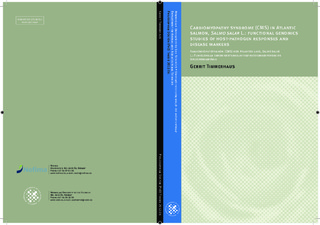| dc.description.abstract | Since the first description of CMS in the mid 1980s, little research has been conducted to approach an understanding of host-pathogen responses in affected Atlantic salmon. The research presented in this thesis aimed to address this topic based on the recent success to reproduce CMS in experimental infection trials.
Transcriptome analysis based on microarrays represents a powerful method for characterization of host responses to complex and unknown traits like infectious diseases. Paper I describes the development of an oligonucleotide microarray with 20,000 unique probes to genes of Atlantic salmon. Pilot experiments assessed performance of this platform. In parallel, a bioinformatics system was constructed. The raw data from microarray experiments are processed and stored in a custom-build database. This database combines the possibilities of annotating genes automatically and manually as well as comparing different experiments to each other and was used in Paper II-IV.
At the beginning of the studies reported in this thesis, the etiology of CMS was still unknown. We conducted a challenge trial by injecting fish with material from cell culture that was expected to contain the causative virus. The challenged fish developed myocardial changes typical for CMS, which were diagnosed by histopathological examination. The biological material of this trial provided the basis of the Papers II and III as well as parts of Paper I and IV. Before Papers II-IV were published, the putative CMS causative virus (piscine myocarditis virus, PMCV) was discovered and sequenced, and viral loads could be measured with real-time RT-PCR.
Paper II describes the regulation of immunological pathways and the development of pathology and viral load in CMS challenged fish during 10 weeks of infection. Myocardial pathology associated with CMS was significant from 6 wpi and peaked at 8-9 wpi followed by a recovery. Viral RNA was detected in all organs from 4 wpi suggesting a broad tissue tropism. High correlation between viral load and cardiac histopathology score suggested that cytopathic effect of infection was a major determinant of the myocardial changes. Strong and systemic induction of antiviral and IFN-dependent genes from 2 wpi that leveled off during infection, was followed by a biphasic activation of pathways for B cells and MHC antigen presentation, both peaking at clinical pathology. This was preceded by a distinct cardiac activation of complement at 6 wpi, suggesting a complement-dependent activation of humoral AB-responses. Peak of cardiac pathology and viral load coincided with cardiac-specific upregulation of T cell response genes and splenic induction of complement genes. Preceding the reduction in viral load and pathology, these responses were probably important for viral clearance and recovery.
While Paper II focused on the immune response of pooled groups of fish developing strongest pathology and infection, Paper III describes a study of individual differences between fish with (so called high responder fish, HR) and without (low responder fish, LR) pathological changes in heart tissues. Global gene expression in HR and LR hearts during infection was compared, in order to characterize differences in the host response and to identify genes with expression patterns that could explain or predict the different outcomes of disease. Virus-responsive genes involved in early antiviral and innate immune responses were upregulated equally in LR and HR at the first stage (2-4 wpi), reflecting the initial increase in virus replication. Repression of heart muscle development was identified by gene ontology enrichment analyses, indicating the early onset of pathology. By six weeks both responder groups had comparable viral load, while increased pathology was observed in HR fish. This was reflected by induced expression of genes implicated in apoptosis and cell death mechanisms, presumably controlling lymphocyte regulation and survival. At the late stage of infection, increased pathology and viral load in HR was accompanied by a broad activation of genes involved in adaptive immunity and particularly T cell responses, probably reflecting the increased infiltration and homing of virus-specific T cells to the infected heart. In contrast, LR fish showed viral clearance and recovery at the late stage, which was associated with activation of genes involved in energy metabolism while adaptive immunity genes were not expressed. These studies (Paper II and III) provide the first characterization of the temporal and spatial regulation of host-virus responses during CMS, as well as correlates and markers of pathology and protection.
Paper IV reports the identification and characterization of early virus responsive genes (VRGs) that are commonly activated in different viral diseases. CMS-related gene expression at early time points was represented by data published in Paper II. The expression data from other studies of viral diseases (heart and skeletal muscle inflammation (HSMI), infectious salmon anaemia (ISA) and infectious pancreatic necrosis (IPN)) and poly I:C treatment were from other experiments stored in the internal database. A total of 117 VRGs were identified, characterized by a rapid induced expression, dependence on the virus level and low tissue specificity. Expression of these genes strongly correlated to expression of IFNα. Some of the highest ranked genes of this study have not been described in the context of virus or immune responses in fish before. According to phylogenetic analyses, a large part of the VRGs has undergone rapid evolution and sequence divergence. | nb_NO |

